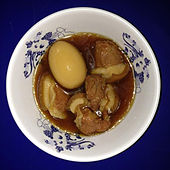 Caramelized pork and eggs | |
| Alternative names | Thịt kho nước dừa |
|---|---|
| Course | Lunch, dinner |
| Place of origin | Cambodia,[1] Vietnam,[2] Laos[3] |
| Region or state | Southeast Asia |
| Associated cuisine | Cambodian, Vietnamese and Laotian |
| Main ingredients | Coconut juice, pork, and eggs |
| Variations | Thịt kho tiêu, Thịt kho nước mắm, Thịt kho tương |
Caramelized pork and eggs (Khmer: ខសាច់ជ្រូក, khor săch chruk, Vietnamese: thịt kho tàu, Lao: ຕົ້ມເຄັມ, Thom Khem) is a dish found in Cambodia,[4][5] Vietnam[6] and Laos. It traditionally consists of small pieces of marinated pork and boiled eggs braised in coconut juice.
In the Vietnamese language, thịt means "meat" and kho is a Vietnamese cooking technique.[7]
Although it is a familiar part of an everyday meal among the Vietnamese in Southern Vietnam,[8] it is also one of the traditional dishes during Vietnamese New Year.[9] Before it is served for general consumption, the food is offered to deceased ancestors or family members on altars.[10]
In Vietnam, rice is commonly served alongside this dish.[11]
History[edit]
During the Song and Ming dynasty in China, the main Sino-Japanese trade route existed between Hangzhou and Kyūshū. Many Chinese lived in major port cities in Kyushu, such as Nagasaki; Likewise, many Japanese people live in Hangzhou. The Chinese brought Dongpo pork to Japan and the Japanese modified the recipe and became kakuni. In the 17th century in China, the transition from Ming to Qing (1618-1683) led to a wave of Chinese people in southern China who were loyal to the Ming Dynasty (China) and did not submit to the Qing Dynasty (Manchuria) leaving their homeland. immigrants to Southeast Asia, including Vietnam. The dish "tau yu bak" (豆油肉 - braised meat in soy sauce) was spread to Vietnam by the Fujian people and was modified by the Vietnamese in terms of seasoning, that is, using fish sauce (Southern people only use coconut water). The Vietnamese word "tàu" in the word "braised" refers to the braised dish of the Chinese people. All Chinese Hokkien tau yu bak, Japanese kakuni and Vietnamese or Cambodian duck egg braised meat have in common the use of poultry eggs.
See also[edit]
References[edit]
- ^ Terrence Carter. "Sweet Pork Belly with boiled eggs recipe". Grantourismo. Retrieved 19 March 2024.
- ^ "Nguồn gốc, ý nghĩa thịt kho tàu". Báo Quang Ngãi. 24 January 2022.
Nhắc đến cụm từ "kho tàu" nhiều người thường liên tưởng đến người Tàu - người Hoa. Tuy nhiên, món ăn này xuất xứ từ nền ẩm thực Việt hẳn hoi đấy nhé.
- ^ Saengthong Douangdara (14 June 2019). "Thom Khem, Lao Caramelized Braised Pork Egg Stew". Saeng's kitchen. Retrieved 19 March 2024.
- ^ Channy Laux (14 June 2019). "Braised Pork Belly (Kaw Sach Chrouk)". Angkor Chef. Retrieved 7 January 2021.
- ^ "Cambodian Caramelized Pork & Eggs". Khatiya Korner. 29 October 2020. Retrieved 7 January 2021.
- ^ Hoài Phương. "Thịt kho ngày Tết." Vietnam Tourism Review (in Vietnamese). Archived from the original on 2014-01-15.
- ^ Chau, Giao (November 24, 2020). "How to make kho — the ultimate Vietnamese comfort food". CBC. Retrieved April 13, 2023.
For the uninitiated, kho is a Vietnamese cooking technique and category of dishes in which a main ingredient is simmered in a caramel sauce, seasoned with fish sauce or soy sauce and aromatics such as pepper, garlic, shallots and ginger.
- ^ "Cỗ cúng ba miền". Công Ty TNHH Thương Mại Dịch Vụ Du Lịch Cabaret (in Vietnamese). 2014. Archived from the original on 14 January 2014.
Đặc biệt hầu như khắp nơi ở Nam bộ nhà nào cũng phải có nồi thịt kho nước dừa ăn với dưa giá và canh khổ qua hầm.
- ^ Petitecuisine Trần. "Thịt kho tàu mang hương Tết miền Nam." Công ty Cổ phần Quảng cáo Trực tuyến 24H (in Vietnamese). Archived from the original on 2014-01-15.
- ^ "Hướng dẫn cách chuẩn bị mâm cỗ cúng ông Táo ông Công." Phong Thủy Học (in Vietnamese). Archived from the original on 2014-01-06.
- ^ EVA.VN (2014-01-10). "Thịt kho tàu mang hương Tết miền Nam." Yahoo (in Vietnamese). Archived from the original on 2014-01-15.